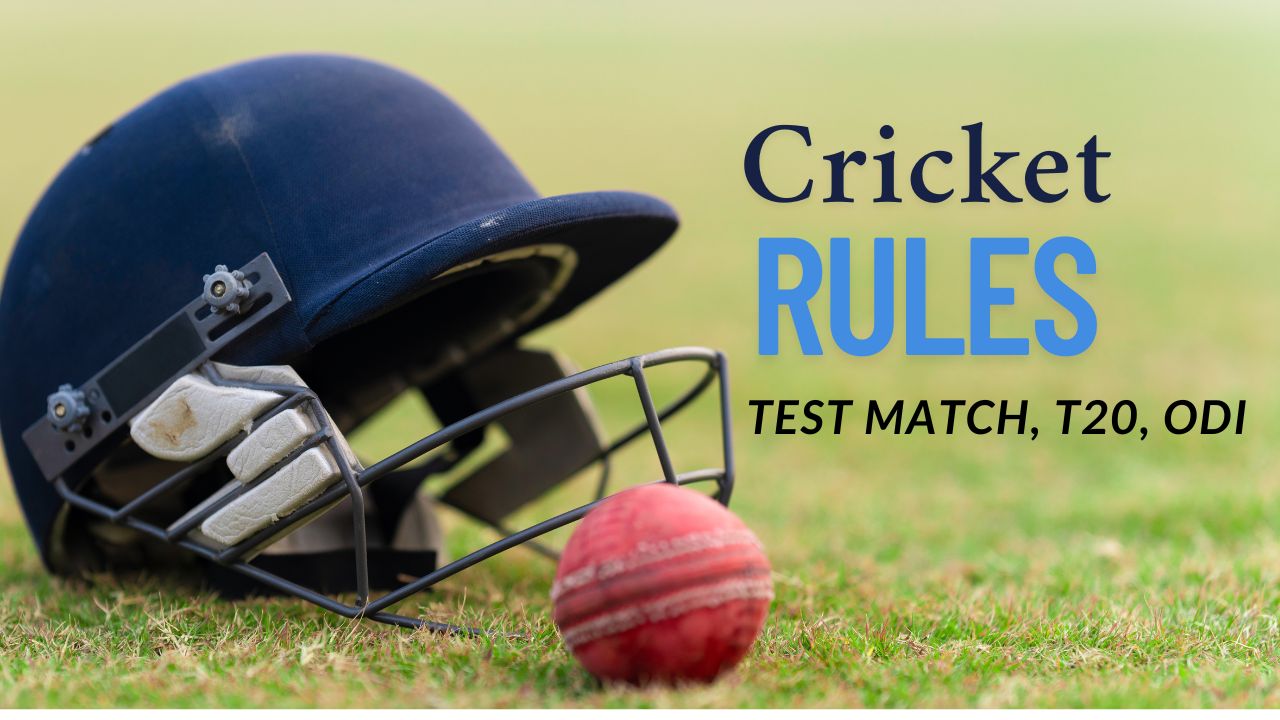ICC Cricket Rules for T20, One Day, and Test Format

In this article, we will explore the ICC Cricket Rules across all three international formats: T20, One Day Internationals (ODIs), and Test Matches. This guide covers everything you need about modern cricket rules and regulations.
🏏 What Are ICC Cricket Rules?
ICC stands for International Cricket Council. The ICC Cricket Rules are globally recognised and applied to all formats—Test, One Day, and T20. However, each format in cricket has specific rules for duration, overs, and field restrictions.Let's explore the ICC cricket rules for all three formats.
1. ICC Cricket Rules for T20 Format
The T20 (Twenty20) format is the shortest and the most famous in modern cricket lovers. It's designed for super excitement and entertainment, and it lasts for 3 hours. Below are some of the important rules set by ICC
- Innings: Each team plays a single innings.
- Overs per Innings: Maximum 20 overs.
- Powerplay: First 6 overs are Powerplay. Only 2 fielders are allowed outside the 30-yard circle.
- Bowling Restrictions: A bowler can bowl a maximum of 4 overs.
- Match Duration: ~3 hours including breaks.
- No-ball Rules: Free hit awarded to the batsman on all types of no-balls.
- Super Over: In case of a tie, one Super Over decides the winner.
- Fielding Restrictions: Only 5 fielders allowed on leg side.
- Timeout: Strategic timeouts allowed in some leagues (like IPL).
2. ICC Cricket Rules for One Day Internationals (ODIs)
One Day Internationals is another interesting format of cricket game. This format of cricket lasts around 7-8 hours. Below are the rules and regulation of ODI format.
- Innings: Each team plays one innings.
- Overs per Innings: 50 overs.
-
Powerplays:
- Overs 1-10: Only 2 fielders allowed outside 30-yard circle.
- Overs 11-40: 4 fielders allowed outside.
- Overs 41-50: 5 fielders allowed outside.
- Bowling Limit: A bowler can bowl a maximum of 10 overs.
- Match Duration: 7-8 hours including a lunch break.
- Tie Scenario: Super Over may be used in knockout stages.
- DRS: Decision Review System is used with 1 review per innings.
3. ICC Cricket Rules for Test Matches
Test cricket is the oldest and most traditional format. It is a five days game which require more strategy, skills, talent.
- Innings: Each team gets 2 innings.
- Overs: No limit on overs. Matches are played over 5 days with 90 overs scheduled each day.
-
Session Timings:
- Morning session: 2 hours
- Lunch: 40 minutes
- Afternoon session: 2 hours
- Tea: 20 minutes
- Evening session: 2 hours
- Follow-On Rule: If Team A leads by 200+ runs after the first innings, they can enforce a follow-on.
- Draw/Tie: Matches can end in a win, loss, draw, or tie.
- Reviews: 2 unsuccessful reviews per innings using DRS.
- White Clothing: Players wear white kits and use red balls.
⚖️ Common ICC Rules Across All Formats
- Dismissals: Bowled, LBW, Caught, Run Out, Stumped, Hit Wicket, etc.
- No-Ball and Wide: Extra runs awarded and the ball is re-bowled.
- Umpires: On-field and third umpires regulate the game.
- Ball Tampering: Strictly prohibited under ICC Code of Conduct.
- Spirit of the Game: Players must respect opponents and officials.
⚠️ ICC Cricket Rules: No-Ball in All Formats
Under the ICC Cricket rule book, a No-Ball is a delivery that violates specific laws of cricket. It results in an extra run and an extra ball. The rules around No-Balls are consistent but vary slightly across T20, One Day Internationals (ODI), and Test formats.
🚫 Common Reasons for a No-Ball in All Formats
- Front Foot No-Ball: The bowler's front foot must land behind the crease line. Overstepping the line results in a No-Ball.
- Back Foot No-Ball: The bowler's back foot must remain within the return crease. Crossing this was also declared a No-Ball.
- High Full Toss (Waist Height): A delivery that reaches the batter above waist height without bouncing is also declared a No-Ball.
- Bowling More Than the Allowed Overs: In limited overs, a bowler exceeding their limit (e.g., 4 in T20, 10 in ODI) results in a No-Ball.
- Throwing or Chucking: An illegal bowling action is penalized with a No-Ball.
- Bowler Hitting the Stumps While Delivering: If a bowler hits the stumps during their delivery stride, it is a No-Ball.
- Fielding Restrictions: If there are more fielders than the specified number, then it is a No-Ball.
📌 No-Ball Rules in T20 Cricket
- Free Hit: Every No-Ball is followed by a Free Hit, which means a batsman can not be out on the very next ball except run out..
- Field Changes: Field cannot be changed for the Free Hit unless the batsmen change their ends.
📌 No-Ball Rules in ODI (One Day Internationals)
- Free Hit: Awarded for front-foot and height-related No-Balls.
- DRS Challenge: No-Balls can be reviewed in certain conditions using DRS.
📌 No-Ball Rules in Test Cricket
- No Free Hit:Oops! No Free Hit is awarded for No-Balls in Test cricket.
🎯 Conclusion
The ICC Cricket Rules ensure fair play, entertainment, and consistency across T20s, ODIs, and Tests. Whether it's the modern format T20, the strategic game of ODI, or the legacy of Test cricket, each format brings unique charm and challenges.
Keep following Informantra.com for amazing information and content.
You may also like:
History of IPL, IPL 2025 Teams, Winners List & How to Watch Live
The Indian Premier League, also known as the IPL, is one of the most popular T20 leagues in...
